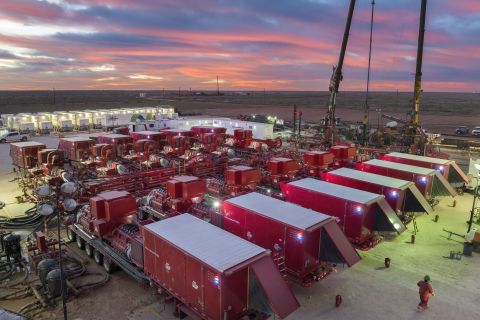Learn more about Hart Energy Conferences
Get our latest conference schedules, updates and insights straight to your inbox.
As the 2008 exploration technology winner of Hart Energy’s Meritorious Awards for Engineering Innovation (MEAs), WesternGeco’s Dynamic Spread Control (DSC) technology improved repeatability of seismic source positioning in time-lapse projects.
After a period of hydrocarbon production typically ranging from one to two years, 3-D seismic surveys are repeated to determine reservoir fluid changes. “Changes in reservoir fluid content and/or pressure can lead to changes in the seismic signal, so mapping differences between two vintages of survey can indicate where hydrocarbon movement has taken place and identify as-yet untapped compartments,” said Paul Bidmead, marine marketing manager for WesternGeco.
Prior to the introduction of DSC technology in 2007, several studies showed that differences in the positions of seismic sources and receivers from one survey to the next could lead to differences in seismic response that could obscure subtle indications of fluid movement. WesternGeco’s Q-Fin marine seismic streamer steering devices enabled vertical and lateral steering to keep receivers as close as possible to the positions of previous surveys. “The addition of DSC technology provided independent steering of the sources in addition to the streamers,” Bidmead said. “Automation of the whole system was the key to taking positioning repeatability of all the elements of in-sea equipment to an unprecedented level of accuracy.”
Using information from a previous survey, multiple GPS measurements, and a dense in-sea real-time acoustic positioning network, a 4-D steering controller automatically steers the vessels, sources, and streamers to achieve the best possible 4-D match.
Since its introduction, DSC technology has been used on a majority of the company’s repeat surveys. “In recent projects, more than 99% of source positions have been within 2 m [7 ft] inline and approximately 98% within 6 m [20 ft] crossline of programmed locations,” Bidmead said. “WesternGeco is the only supplier of seismic services that can provide this level of positioning repeatability.”
The DSC system remains virtually unchanged since being introduced and remains a key component of WesternGeco’s marine seismic positioning system. The company has, however, made several operational changes to its TRINAV integrated navigation and positioning system, of which DSC is a part. TRINAV serves as a tool to help position the seismic vessel, sources, and streamers.

Shown are the results of a 2007 test in which two vessels attempted to keep their sources on a straight pre-plot baseline. The DSC-equipped vessel kept its sources much closer to the baseline than the vessel steered manually. (Image courtesy of WesternGeco)
In 2012, WesternGeco introduced IsoMetrix marine isometric seismic technology, which aims to deliver high-fidelity point-receiver seismic data while overcoming spatial wavenumber bandwidth compromises.
The IsoMetrix technology works in tandem with the Nessie-6 point-receiver streamer system, which uses hydrophones and calibrated point-receiver microelectromechanical system accelerometers to measure the full particle acceleration of the upgoing and downgoing seismic wavefield. “Direct measurement of the vertical and crossline gradient enables unaliased reconstruction of the pressure wavefield between the streamers,” Bidmead said, adding, “The TRINAV positioning system, including DSC, is an integral part of the new seismic acquisition system.”
Recommended Reading
From Restructuring to Reinvention, Weatherford Upbeat on Upcycle
2024-02-11 - Weatherford CEO Girish Saligram charts course for growth as the company looks to enter the third year of what appears to be a long upcycle.
TechnipFMC Eyes $30B in Subsea Orders by 2025
2024-02-23 - TechnipFMC is capitalizing on an industry shift in spending to offshore projects from land projects.
XGS Energy Secures $9.7MM in New Financing
2024-01-23 - XGS Energy's latest funding round will demonstrate the commercial readiness and scalability of its new thermal reach enhancement technology.
Halliburton Posts High Operating Margins for 2023
2024-01-24 - Halliburton’s CEO Jeff Miller says service intensity contributes to ongoing strong oilfield service fundamentals.
NOV's AI, Edge Offerings Find Traction—Despite Crowded Field
2024-02-02 - NOV’s CEO Clay Williams is bullish on the company’s digital future, highlighting value-driven adoption of tech by customers.





